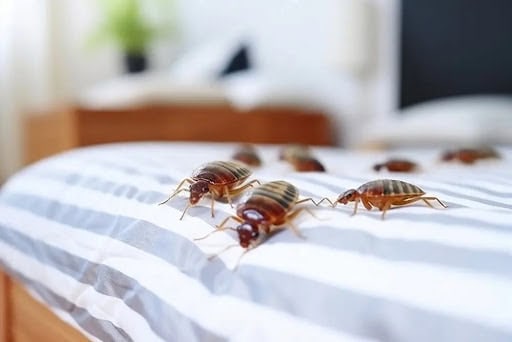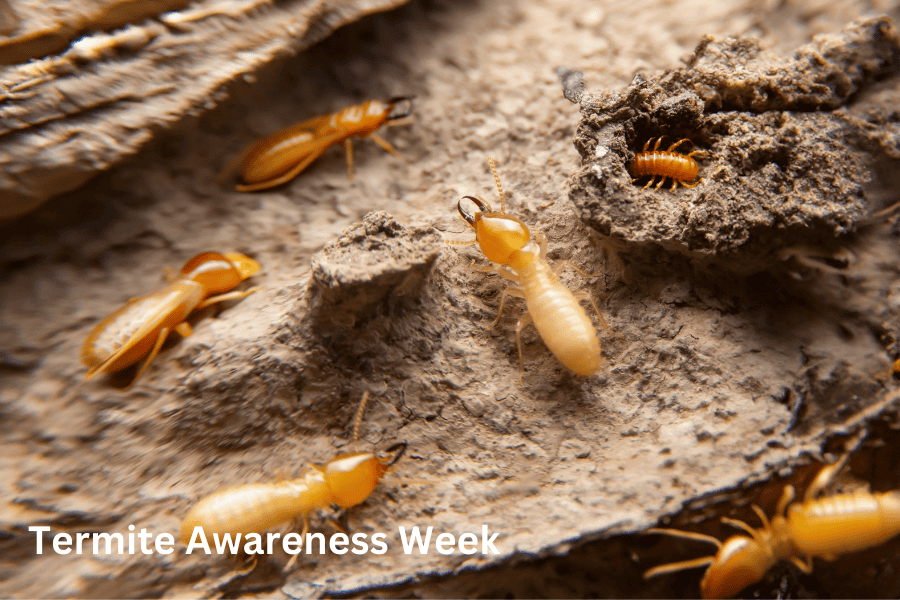READY TO GET STARTED?
REQUEST A FREE ESTIMATE
Fill out the form below or call (888) 466-7849 for a free, no-obligation estimate.

Bees are essential to our ecosystem. They pollinate flowers, fruits, and vegetables, making them integral for Tennessee’s lush gardens and thriving agriculture. However, typical pest control practices often inadvertently harm these invaluable insects. As a Tennessee homeowner, balancing pest control with environmental responsibility is a challenge—but not an impossible one. This guide focuses on bee-friendly pest control practices that help protect these vital pollinators while keeping your home and garden pest-free.
Bees are not just important for the environment—they contribute directly to the economy of states like Tennessee. From pollinating crops like apples, watermelon, and pumpkins to supporting wildflower blooms that benefit local wildlife, bees play a huge role. Unfortunately, widespread pesticide use has been a key contributor to the decline of bee populations. This decline could have dire consequences for agriculture and biodiversity.
But with a few mindful changes to your pest control approach, you can support pollinator health while maintaining your home’s comfort and well-being. Read below to find out how!
When using pesticides, the timing of your application is one of the most critical factors for bee protection. Bees are most active during the daytime—typically from mid-morning to late afternoon. Applying pesticides during these peak hours increases the likelihood of exposing them to harmful chemicals. To minimize the risk, consider scheduling treatments in the early morning or late evening when bees are less active.
Instead, opt to spray pesticides:
By targeting these times, you reduce the chances of directly affecting bees while ensuring pests are still managed effectively. You can also ask your local pest control company if they can accommodate bee-friendly application times to further protect these important pollinators.
Not all pesticides are created equal. Some are formulated to minimize harm to beneficial insects like bees. When choosing a professional pest control company, look for those explicitly labeled as “bee-protected or “non-toxic to pollinators.”
Here’s what to avoid and what to consider:
These products allow you to take care of garden pests without risking the health of your local bee population. If in doubt, consult a pest control professional who prioritizes environmentally-friendly solutions.
Blanket-spraying your entire yard is not only unnecessary but also harmful to the environment. This approach increases pesticide exposure for non-targeted species, including bees. Instead, focus on spot-treating problem areas where pests are concentrated.
How to spot-treat effectively:
Spot-treating is a more targeted strategy that minimizes collateral damage to bees and other beneficial insects.
Bees rely on flowering plants for food, so when applying pest control measures, it’s crucial to leave a portion of your yard bee-friendly. Reserving areas of blossoming plants untouched by pesticides creates foraging zones for pollinators.
To encourage a pollinator environment:
By creating these havens, you ensure that bees can continue to thrive, even while managing pests elsewhere in your yard.
Companion planting involves pairing specific plants that naturally repel pests with your garden crops. For instance:
This natural method not only reduces your need for chemical pesticides but also supports pollinator activity.
While dandelions and clovers may be considered weeds, they’re important food sources for bees. Limiting mowing in areas where these plants grow allows pollinators to access vital nutrients, particularly in early spring.
For a sustainable pest control approach, partner with an eco-friendly company that prioritizes honeybee protection. Many services in Tennessee offer solutions that target pests while keeping pollinators unharmed. Homeowners can help by adjusting pesticide timing, choosing non-toxic treatments, and creating foraging zones. If a beehive ends up in an unwanted spot, contact our honeybee experts to responsibly rehome it.

Bed bugs—the very mention of them is enough to make any homeowner uneasy. These tiny, elusive pests can invade even the cleanest of homes, causing itchy bites, restless nights, and a lot of frustration. But how can you keep your home pest-free while ensuring effective bed bug control? This guide covers proven methods to manage infestations and prevent future issues, giving you the tools and knowledge to protect your home and family.
Miami’s warm temperatures and bustling travel industry make the city more prone to bed bug infestations. Bed bugs thrive in heat, and with so many people traveling to and from the city, these pests can hitch rides on luggage, furniture, and even clothing.
Furthermore, as bed bugs are nocturnal and excellent at hiding in nooks and crannies, they can remain undetected until they’ve established a full infestation. If not effectively managed, the problem can worsen, affecting your quality of life and requiring costly interventions.
Spotting bed bugs early can save you a lot of trouble. Here are the key signs to watch out for in your Miami home:
Bed bug bites often appear as small, red welts on the skin, typically clustered in lines or groups. Bites may be itchy, but some individuals show no reaction at all.
Look for rust-colored spots on bedding, mattresses, or upholstery. These stains occur from crushed bed bugs or their excrement.
Bed bugs shed their exoskeletons as they grow. You might notice tiny, pale shells or eggs (about the size of a pinhead).
In severe infestations, an unpleasant, musty smell—caused by bed bugs’ scent glands—may be noticeable.
Lastly, you might spot one moving around areas where people sleep or relax. Adult bed bugs are about the size of an apple seed, reddish-brown, and oval-shaped.
Once you’ve identified a bed bug problem, it’s time to take action.
Essential oils like tea tree oil and lavender have some insecticidal properties, making them a mild deterrent. While not strong enough to eradicate infestations, they can complement other treatments.
Encasing mattresses and box springs in bedbug-proof covers traps existing bed bugs inside and prevents future infestations in those areas.
Effective bed bug control doesn’t stop at treatment—preventive measures are just as important. Incorporate these strategies into your routine to keep your home infestation-free:
Inspect your bedding, furniture, and luggage for signs of bed bugs, especially after traveling or hosting guests.
Be cautious with second-hand furniture. Inspect all items thoroughly before bringing them into your home.
Reducing clutter eliminates hiding spots for bed bugs and makes cleaning more efficient.
Wash bedding, curtains, and clothing in hot water and dry on high heat to remove ny hidden bugs.
When staying in hotels or vacation rentals, inspect the mattress seams and avoid placing luggage on the bed. After traveling, immediately launder and dry your clothing.
Dealing with a bed bug infestation can be stressful, but choosing the right treatment ensures your Miami home is protected. Effective bed bug control focuses on proven methods that eliminate infestations and provide long-term relief. Consult with a local pest control professional to ensure safe and thorough treatment tailored to your home and family’s needs.

Bees play a remarkable role in maintaining our ecosystem. Their tireless work as pollinators supports the growth of plants that provide food, oxygen, and habitat for countless species, including us. However, when bees decide to make their home just a little too close to yours, it can pose challenges for homeowners. If you’ve noticed increased bee activity around your house, don’t panic! This guide will help you recognize the signs of a potential bee infestation and explain how professional help can manage the situation while staying out of harm’s way.
Before you assume you have a bee infestation, it’s important to identify the signs. Here are some telltale indicators that bees may have established a colony on your property:
Seeing a few bees in your yard is perfectly normal, especially in garden-friendly states like Georgia. But if you notice a consistent stream of bees flying to and from a specific location, it could be evidence of a nearby colony.
Bees commonly build their colonies within the walls or ceilings of homes. If you hear a faint but steady humming sound, especially in quiet rooms, it could be the sound of an active colony.
If bees have built a colony inside your walls, over time, melted honey or wax may create sticky or dark stains on surfaces. Inspect areas with staining or discoloration to check for other signs of bee activity.
Check attics, vents, chimneys, or exterior cracks in the foundation. Bees are resourceful when it comes to nesting, and these areas are common colony building spots.
A bee swarm can understandably seem alarming, but swarms are often temporary . Swarming typically happens when bees are searching for a new nesting site. If they’re congregating nearby, they might be looking to settle on your property.
We understand you might be tempted to address the problem yourself. However, when it comes to bees, DIY efforts can sometimes make matters worse. Here’s why leaving it to a professional is essential:
If you’ve identified signs of a bee infestation, partnering with a professional bee relocation service is the next best step. Specialists in handling bee situations offer tailored solutions that balance your needs as a homeowner with the wellbeing of the bee population. Here’s how experts can assist:
As a homeowner, it’s normal to feel concerned when bees settle a little too close for comfort. But with expert guidance and humane solutions, managing a bee infestation can be as stress-free as possible. Protect your home and support local pollinators by reaching out to your local bee removal experts today!

Spring in Naples is a time of renewal—clear blue skies, lush greenery, and blooming flowers. But with warmer temperatures and rising humidity come some less welcome visitors—household pests like ants, mosquitoes, and rodents. While dealing with pests is a reality for most homeowners during spring, traditional pest control methods can harm the environment, your health, and your home. This year, why not take a sustainable approach? Protect your home, loved ones, and the natural beauty of Naples with these eco-friendly pest control tips.
Now that you’re ready to adopt sustainable pest control methods, let’s tackle some of the most common springtime pests in Naples homes.
Ants are a persistent problem and can quickly become an indoor nuisance. Instead of reaching for chemical sprays, consider these eco-conscious strategies.
Mosquitoes not only cause itchy bites but can also carry diseases. The combination of warm weather and sitting water in Naples makes this region particularly susceptible.
Rodents are drawn to warm homes and readily available food supplies, especially as the season changes.
By choosing eco-friendly pest control methods, Naples homeowners can help protect the beautiful community while maintaining a healthy home. Simple steps like using natural deterrents, along with professional green treatments, can deliver effective results while being kind to the environment. Sustainable pest control services not only target pests but also reduce the impact on local ecosystems, giving homeowners peace of mind and a pest-free home.

Termites may be small, but their destructive power is anything but. Each year, these silent invaders cause billions in property damage, and in Bonita Springs, Florida—a place where the warm, humid climate is a perfect breeding ground for termites—preventing these pests is crucial for homeowners, making eco-friendly termite control a priority for Florida homeowners.
This Termite Week, we’re spotlighting sustainable, eco-friendly termite control methods that not only protect your property but also protect the environment. Traditional treatments often rely on harsh chemicals that can harm both human health and local ecosystems. Thankfully, green termite control offers a smarter, healthier way to eliminate these pests. If you’re looking for environmentally conscious ways to protect your home, this guide covers effective green solutions for termite control.
Bonita Springs may be known for its sunny skies and beautiful beaches, but it’s also a prime location for termite infestations. The tropical climate and abundant wood sources make it a haven for both subterranean and drywood termites. Here’s why termites pose such a threat:
Understanding their behavior and acting quickly is key to preventing these hidden threats.
While traditional methods—like chemical pesticides—are effective at eliminating termites, they can also harm the environment. These chemicals can seep into the soil, affecting beneficial insects, plants, and even water sources. Fortunately, eco-friendly termite solutions are making it possible to control termites without resorting to harmful chemicals.
Eco-friendly termite control options are gaining popularity for their effectiveness and sustainability. Here’s how you can combat termites the green way:
Baiting systems strategically place stations around your home, containing growth regulators that termites carry back to the colony, eliminating them at the source.
Why it’s green: Minimal chemical use and focused, targeted treatment for insects that shed their exoskeleton.
Installing physical barriers such as sand or steel mesh around your home prevents subterranean termites from gaining access.
Why it’s green: Long-lasting protection without chemicals.
Boric acid disrupts termites’ digestive systems, effectively eliminating them.
Why it’s green: Low toxicity and can be directly applied without harming other organisms.
Orange oil, derived from orange peels, disrupts termites’ respiratory systems and prevents them from laying eggs.
Why it’s green: Plant-based, biodegradable, and effective for localized infestations.
Green termite control doesn’t end with treatment. Regular inspections are vital for early detection. Pest control professionals use non-invasive methods . Ongoing monitoring systems can also be set up to track termite activity throughout the year, ensuring long-term protection.
Prevention is key to avoiding termite infestations. Here are simple ways to reduce the likelihood of attracting termites:
Termites don’t have to threaten your home or your environmental values. Eco-friendly termite control methods offer a sustainable solution that’s effective in keeping your home guarded from these destructive pests.
This Termite Week, take action to protect your home with green termite control practices. Reach out to a local pest control professional who specializes in sustainable solutions and protect your home while keeping the environment intact.